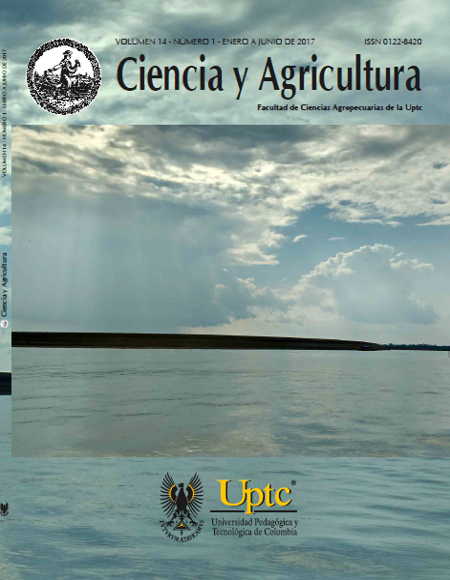Characterization of the guinea pig (Cavia porcellus) meat for fermented sausage preparation

Abstract
Guinea pig meat, due to its high nutritional value, is important in the human diet, and is a key product for food safety; additionally, this meat is used in the agroindustry production, and people who consume it are less prone to diseases. The objective of the investigation was to characterize the guinea pig meat, for its possible use in the elaboration of an improved fermented sausage. The lines of guinea pig evaluated were the Creole, Andean and Peruvian.
Meat was characterized using analysis of variance for differences and means comparison, according to Duncan (p<0,05), from a physicochemical, microbiological and sensorial point of view. The moisture content did not show differences between the three evaluated lines, whose values were 75.6 % in the Andean, 73.3 % in the improved Peruvian, and 72.7 % in the Creole. The highest protein content was 19.1 % in the Creole, which also had the lowest fat content (7.6 %). In regard to the meat microbiological and sensorial characteristics, it complied with the quality requirements established by the respective standards. The guinea pig meat quality allows its use in a meat product formulation.
Keywords
cavia porcellus, guinea pig, guinea pig andean, guinea pig creole, improved peruvian.
References
- Avilés D, Landi V, Delgado J, Martínez A. El pueblo ecuatoriano y su relación con el cuy. AICA. 2014; 4: 38-40.
- Santos V. Importancia del cuy y su competitividad en el mercado. Arch. Latinoamérica de Producción Animal. 2007; 15(1): 216-217.
- Chávez S. Tecnologías de Producción y Comercialización de carne de cuy procesada para el mercado nacional y de exportación. Editorial GOYOQ. Lima, Perú. 2013.
- Argote F, Cuervo R. Agroindustrialización de la carne de cuy. Revista Guillermo de Ockham. 2012; 10 (2): 217-218.
- Calzada J. Crianza del cuy (cavia porcellus). Rvta. ACPA. 2009:19.
- RTE INEN: 056. Carne y productos cárnicos. Instituto Ecuatoriano de Normalización. 2013.
- NTE INEN: 776. Carne y productos cárnicos. Muestreo. Instituto Ecuatoriano de Normalización. 1985.
- NT INEN: 1529-2. Control microbiológico de los alimentos. Toma, envío y preparación de muestras para el análisis microbiológico. Instituto Ecuatoriano de Normalización. 1999.
- AOAC. Ed 19, 925.10. Meat and meat products. Determination of humidity. Association of Official Analytical Chemists. 2012.
- AOAC-19 2001.11. Meat and meat products Protein determination. Association of Official Analytical Chemists. 2012.
- AOAC-19.991.36. Meat and meat products. Fat determination. Association of Official Analytical Chemists. 2012.
- AOAC-19.923.03. Meat and meat products. Determination of ash. Association of Official Analytical Chemists. 2012.
- NTE INEN 783:85. Carne y productos cárnicos, Determinación del pH. Instituto Ecuatoriano de Normalización. 2012.
- AOAC -19. 991.14. Meat and meat products. Determination of total coliforms. Association of Official Analytical Chemists. 2012.
- AOAC-19. 991.14. Determination of Escherichia coli. Association of Official Analytical Chemists. 2012.
- AOAC-19. 998.09. Determination de Salmonella spp. Association of Official Analytical Chemists. 2012.
- AOAC-19. 2003.11. Determination de Staphylococcus aureus. Association of Official Analytical Chemists. 2012.
- Espinoza J. Evaluación sensorial de los alimentos. Editorial Universitaria, Ministerio de Educación Superior de Cuba. 2014.
- NC ISO: 1035. Análisis sensorial. Identificación y selección de descriptores para el establecimiento de un perfil sensorial mediante un enfoque multidimensional. Oficina Nacional de Normalización de Cuba. 2015.
- Apráez J, Fernández L, Hernández A. Efecto del empleo de forrajes y alimentos no convencionales sobre el comportamiento productivo, rendimiento y calidad de la carne de cuyes (Cavia porcellus). RevVet. Zootec. 2008; 2(2): 29-34.
- Coronado D, Parrado M. Mejorando la crianza de cuyes en Cutervo, microcuenca del Chotano. Escuela Campesina de Educación y Salud. Lima, Perú. 2010.
- Malavé A, Córdova L, García A, Méndez J. Rev. MVZ Córdoba. 2013; 18(2): 3452-3458. DOI: https://doi.org/10.21897/rmvz.167
- Cury K, Martínez A. Caracterización de carne de conejo y producción de salchicha. Rev. Colombiana Ciencia Animal. 2011; 3(2): 269-282. DOI: https://doi.org/10.24188/recia.v3.n2.2011.377
- Nakandakari L, Gutiérrez E, Chauca L, Valencia R. Medición del pH intramuscular del cuy (Cavia porcellus). Rev. Salud Tecnol. Vet. 2014; 2: 99-105. DOI: http://doi.org/10.20453/stv.v2i2.2246. DOI: https://doi.org/10.20453/stv.v2i2.2246
- NTE INEN: 1346. Carne y productos cárnicos. Carne molida. Requisitos. Instituto Ecuatoriano de Normalización. 2010.